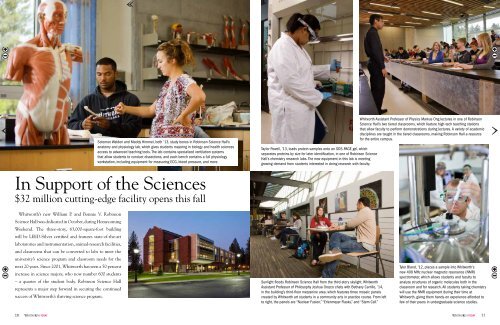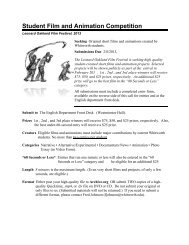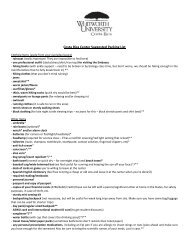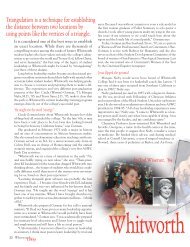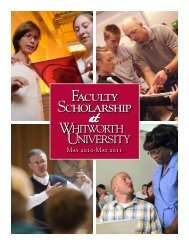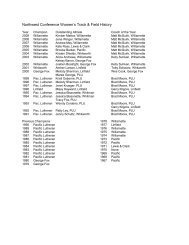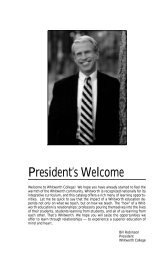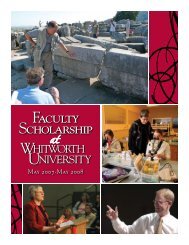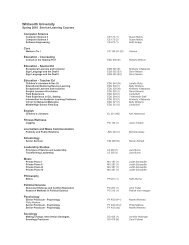Alums Get Down to Business What can Whitworth graduates do with ...
Alums Get Down to Business What can Whitworth graduates do with ...
Alums Get Down to Business What can Whitworth graduates do with ...
Create successful ePaper yourself
Turn your PDF publications into a flip-book with our unique Google optimized e-Paper software.
10<br />
<strong>Whitworth</strong>’s new William P. and Bonnie V. Robinson<br />
Science Hall was dedicated in Oc<strong>to</strong>ber, during Homecoming<br />
Weekend. The three-s<strong>to</strong>ry, 63,000-square-foot building<br />
will be LEED-Silver certified and features state-of-the-art<br />
labora<strong>to</strong>ries and instrumentation, animal-research facilities,<br />
and classrooms that <strong>can</strong> be converted <strong>to</strong> labs <strong>to</strong> meet the<br />
university’s science program and classroom needs for the<br />
next 20 years. Since 2001, <strong>Whitworth</strong> has seen a 50 percent<br />
increase in science majors, who now number 600 students<br />
– a quarter of the student body. Robinson Science Hall<br />
represents a major step forward in securing the continued<br />
success of <strong>Whitworth</strong>’s thriving science program.<br />
TODAY<br />
Solomon Walden and Maddy Himmel, both ’13, study bones in Robinson Science Hall’s<br />
ana<strong>to</strong>my and physiology lab, which gives students majoring in biology and health sciences<br />
access <strong>to</strong> advanced teaching <strong>to</strong>ols. The lab contains specialized ventilation systems<br />
that allow students <strong>to</strong> conduct dissections, and each bench contains a full physiology<br />
workstation, including equipment for measuring ECG, blood pressure, and more.<br />
In Support of the Sciences<br />
$32 million cutting-edge facility opens this fall<br />
Taylor Powell, ’13, loads protein samples on<strong>to</strong> an SDS-PAGE gel, which<br />
separates proteins by size for later identification, in one of Robinson Science<br />
Hall’s chemistry research labs. The new equipment in this lab is meeting<br />
growing demand from students interested in <strong>do</strong>ing research <strong>with</strong> faculty.<br />
Sunlight floods Robinson Science Hall from the third-s<strong>to</strong>ry skylight. <strong>Whitworth</strong><br />
Assistant Professor of Philosophy Joshua Orozco chats <strong>with</strong> Bethany Carrillo, ’14,<br />
in the building’s third-floor mezzanine area, which features three mosaic panels<br />
created by <strong>Whitworth</strong> art students in a community arts in practice course. From left<br />
<strong>to</strong> right, the panels are “Nuclear Fusion,” “Erlenmeyer Flasks,” and “Stem Cell.”<br />
<strong>Whitworth</strong> Assistant Professor of Physics Markus Ong lectures in one of Robinson<br />
Science Hall’s two tiered classrooms, which feature high-tech teaching stations<br />
that allow faculty <strong>to</strong> perform demonstrations during lectures. A variety of academic<br />
disciplines are taught in the tiered classrooms, making Robinson Hall a resource<br />
for the entire campus.<br />
Tyler Bland, ’12, places a sample in<strong>to</strong> <strong>Whitworth</strong>’s<br />
new 400 MHz nuclear magnetic resonance (NMR)<br />
spectrometer, which allows students and faculty <strong>to</strong><br />
analyze structures of organic molecules both in the<br />
classroom and for research. All students taking chemistry<br />
will use the NMR equipment during their time at<br />
<strong>Whitworth</strong>, giving them hands-on experience afforded <strong>to</strong><br />
few of their peers in undergraduate science studies.<br />
TODAY<br />
11


